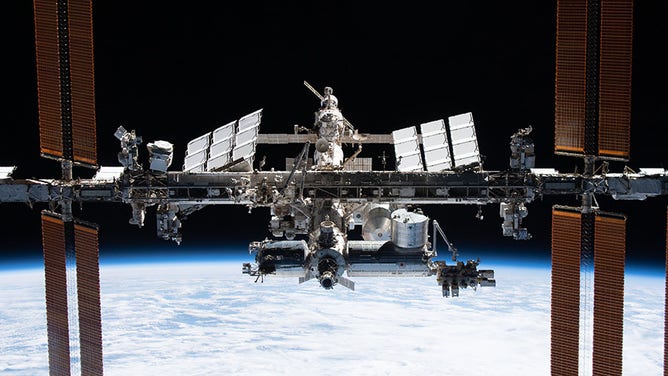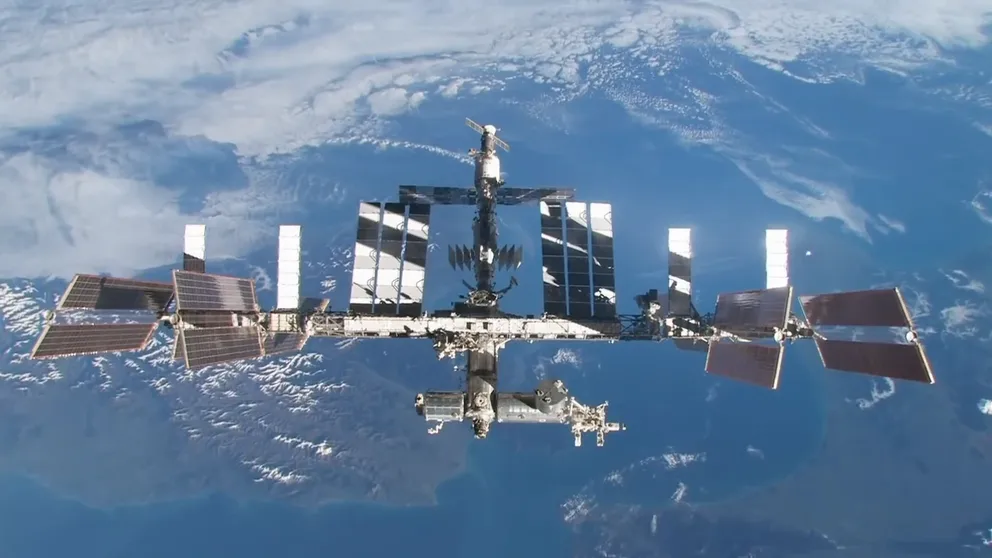Study: Air filters on International Space Station capture forever chemicals, fire retardants
Researchers say higher concentrations of PFAS, or forever chemicals, were found in the dust from the International Space Station. Overall, the flame resistant chemicals found from the filter sample were about the same as a U.S. household, according to the study.
What is the International Space Station?
The International Space Station (ISS) has hosted astronauts living and working in space for more than two decades, making groundbreaking contributions to technology and medicine along the way.
Fire retardant and forever chemicals were found in the air filters onboard the International Space Station in levels that range from those found in an average U.S. home or much higher, according to a new study published this week using dust from the ISS air filter.
Unlike Earth, where particles rest on furniture and household items, dust aboard the ISS floats through the air in microgravity. HEPA air filters on the station accumulate debris and require weekly vacuuming by NASA and international astronauts.
The study published in Environmental Science and Technology Letter used a sample of dust vacuumed up by astronauts from the ISS air filter and saved as part of the Divert Unwanted Space Trash (DUST) experiment in 2019.
Study co-author environmental chemist Stuart Harrad, with the University of Birmingham UK, explained that researchers found just about all 30 chemical contaminants they were looking for when the 1-gram (0.04-ounce) dust sample was analyzed using three different chemistry processes.
The team looked for brominated flame retardants (BFRs), which can be found on electronic equipment and in furniture and other classes of chemicals containing flame retardants, as well as perfluoroalkyl substances (PFAS), also known as forever chemicals.
Researchers then compared the chemical levels to those found in U.S. homes and schools.
ARTEMIS II ASTRONAUTS MEET THEIR SPACECRAFT AHEAD OF LATE 2024 MOON LAUNCH
"Most of the material you have that goes on (the ISS) is from the states," Harrad explained. "We felt the best sort of reference point was to compare it with some studies that have been done looking at house dust and school dust, just basically sort of dust from indoor environments in the U.S."
Harrad said that, for the most part, the chemicals were within the median values found in American homes. However, there were some in higher ranges.
PFAS were found in the dust particles vacuumed out of the air filters on the ISS, according to the study.
Forever chemicals earned the nickname because the synthetic chemicals are nearly indestructible and usually fire, stain and water-resistant. The ISS has been in orbit for 25 years. In that time, those chemicals found in food packaging, clothing and cosmetics have been widely restricted in use or banned.
Of the PFAS the researchers looked at, PFOA (Perfluorooctanoic acid) was found at a concentration of 2,600 ng/g, exceeding 140 ng/g, the median concentration found in U.S. homes.

The International Space Station as seen from the SpaceX Crew Dragon Endeavour during its departure on Nov. 8, 2021.
(NASA)
"The concentration of this PFOA was higher than the average in U.S. homes, and indeed, it was higher than the highest concentration that was seen in that study of U.S. homes," Harrad said.
"We have seen higher concentrations elsewhere, including in the U.K., but it's certainly right at the high range of what we might see," he added.
The researchers think the chemical may have come from materials used on the International Space Station to prevent moisture growth on fabrics. PFOA can be found in heat-resistant coatings used in cookware, as well as waterproofing fabrics. People can also be exposed to PFOA through drinking water, according to the Centers for Disease Control and Prevention.
"You've got this very confined environment, and they're worried about too much moisture on fabrics leading to microbial growth. That could be, sort of, a real problem for people on board," Harrad said. "So they try and use some chemicals to sort of waterproof the fabrics as much as possible."
Harrad said the forever chemicals are likely not new to the ISS and could have been introduced at some point over the 20-year history of the orbiting space station.
Overall, for the air the astronauts breathe, the study found that chemical exposure was above the average within U.S. homes but not outside the median range.
When reached for comment about the study, a NASA spokesperson said via email the research "demonstrates International Space Station HEPA filters are working as designed and are removing contaminants from the air in order to minimize crew exposure risk."
"The recently published study analyzed dust collected from vacuum bags after passing through high-efficiency particulate air filters, or HEPA filters, aboard the International Space Station. Although the study provides valuable data, caution should be used when translating findings into real-world crew health risks," NASA said.
Harrad said the study could help inform material choices for future space missions.
"You need to be careful about the material choices that you make," Harrad said. "People are in that one environment, and it's a contained environment. You have to be, of course, very careful about what they breathe."
ISS astronauts typically spend six months or more in orbit before returning to Earth. NASA has plans for long-duration missions to the Moon, and eventually, Mars requiring years in space.
"NASA takes its responsibility for the health and safety of the astronauts very seriously, and thoroughly evaluates all spacecraft environmental hazards including flammability, noise, radiation, and atmospheric contaminants," a NASA spokesperson said. "The selection, testing, and monitoring of materials has been an important element of spacecraft safety throughout NASA’s history, and research from the International Space Station is critical for mitigating the risks of human spaceflight," the statement read."
